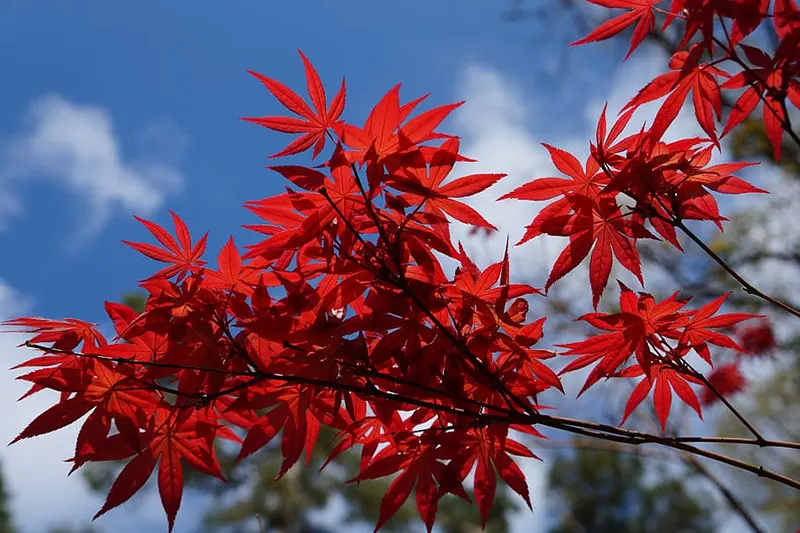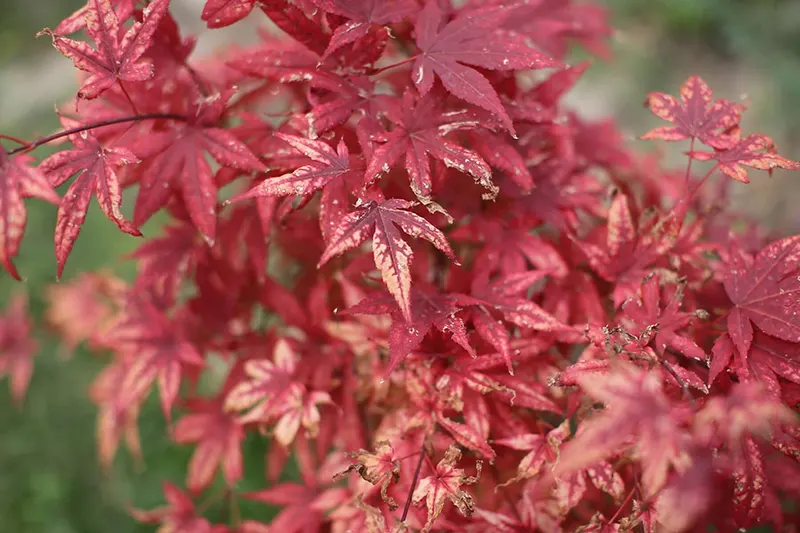Bloodgood Japanese Maple
Gorgeous throughout the year, the Bloodgood Japanese maple is an excellent tree you can start growing at home. The species is welcoming to both new and veteran bonsai enthusiasts. The Bloodgood maple grows with a soft red leaf in a lace-like structure.
Caring for the Bloodgood Japanese maple is a simple task if you follow our guide. The tree requires a lot of water, sometimes needing water more than once a day. From the type of soil you use to the frequency of pruning, we explain everything you need to know.
Here's what you'll find in this Bloodgood Japanese maple bonsai guide:
Here's what you'll find in this Bloodgood Japanese maple bonsai guide:
01
02
03
04
05
Quick Bloodgood Japanese Maple Bonsai Care Sheet
Here’s a quick guide to use as a brief overview of the needs of this tree. The table is short and to the point but lacks excess detail newcomers will find handy.
Recommended soil
Well-draining soil such as an akadama mixture.
Watering
Water once a day, if not more frequently.
Potting season
Every two years regardless of age.
Shaping and pruning season
Prune large branches during autumn for best results. Spring and summer are best for finer trimming.
Light
Plenty of light per day. Protect from summer afternoon sunlight.
Fertilizing
Use a solid organic fertilizer. Add liquid fertilizer once a week if a stronger option is needed.
Propagation methods
Seeds, air layering, and cutting.
Pests and diseases
Aphids and fungal infections, including verticillium wilt.
How to Care for Your Bloodgood Japanese Maple Bonsai Tree
Caring for your Bloodgood Japanese maple bonsai is an easy task once you know what to do. This section will explain the day-to-day requirements to grow a healthy and thriving tree. From soil to pruning, we explain everything in-depth.
Best Soil
The best soil you can use for a Bloodgood Japanese maple is the akadama mix containing pumice and lava rocks. This specific mixture will retain more moisture, lessening the watering frequency of the tree. However, with more water retention, you’ll need to be careful not to over-water and keep the soil wet for too long.
Alternatively, a regular bonsai soil mixture that is well-draining will work just as well. However, the soil will retain less water and may increase your watering frequency.
Watering
The Bloodgood maple is a highly thirsty bonsai tree, often requiring you to water it more than once a day. This high watering frequency may seem like a chore but will keep your bonsai surviving and thriving for many years if you water as needed.
Using a different soil mixture will aid your water retention and lessen watering frequency.
Repotting
Every two years, you should repot the Bloodgood Japanese maple bonsai. There are multiple reasons you should keep to this schedule. One of the most prominent reasons for this procedure is to help prevent fungal infections as the roots grow.
It’s also essential as the tree’s roots regrow rapidly, often filling your pot within two years. This growth rate can lead to nutrient issues, cleanliness problems, and other adverse effects on your bonsai’s health.
Shaping and Pruning
Shaping and pruning your bonsai can be done throughout most of the year. The smaller pieces, such as leaves, shoots, and twigs, are trimmable throughout the entire year. It would be best only to trim these sections every year or two less frequently to encourage finer leaf growth.
Larger branches will need to be pruned and cut during late summer or autumn. When cutting those parts, you’ll need to have cut-paste ready. Apply this after severing the branches to prevent infection as the tree is prone to fungal diseases.
Location and Sunlight
Keep your Bloodgood Japanese maple bonsai in a well-lit and well-aired area. This tree requires a couple of hours per day, preferably morning sun, as the afternoon summer sun is dangerous to your tree and its reddish leaves. This need for protection holds true, especially when temperatures reach above 85 °F.
During winter, the tree requires protection from the cold. Especially temperatures that reach below 15 °F. The bonsai is somewhat frost resistant but will suffer when these lower temperatures are reached.
Fertilizing
A good fertilizer for the Bloodgood Japanese maple bonsai is a solid organic fertilizer that’s low in nitrogen content. Too much nitrogen will cause your tree’s leaves to grow larger than average and may cause the tree to appear odd. This element may also affect your tree leave’s coloring.
If you’re looking for a more potent fertilizer when the tree is healthy and yearning for more nutrients, mix in a liquid option. Only use this additive once a week to not drown the tree in nutrients.
Propagation Methods
Seeds, cuttings, and air layering are all viable methods. However, these should be done during autumn for the best effect.
Pests and Diseases
The most common and annoying pest you’ll find attracted to your Bloodgood Japanese maple is the aphid. This tiny nuisance enjoys drinking the sap from your bonsai; however, they are easily repelled. Frequently mist your tree with water to keep the pests away; however, if they begin to infest your bonsai use regular insecticide to kill the aphids.
Verticillium wilt is a lethal fungal infection that can plague your bonsai. To help increase the chance of your bonsai surviving this, we have a few tips. Trim away all the infected parts of your tree, repot it, clean the pot, and keep the tree well-nourished with water and fertilizer. These small things will help keep your bonsai alive. Additionally, keep other plants away from your diseased bonsai as the infection is contagious.
Considerations for Growing an Indoor Bloodgood Japanese Maple
When growing any outdoor bonsai indoors, there are always essential pieces of information to know. Growing your Bloodgood inside requires careful attention to its placement and how the new environment will affect its leaf coloring.
Location
When growing the Bloodgood indoors, it’s essential to place it in an area that receives both sun and fresh air. A sun-facing window is one of the most ideal locations for this bonsai, especially if you can open the window during the warmer seasons.
A sun-facing window that receives morning sunlight is the best option, as this will protect the tree from the afternoon sun during the summer, which can harm your tree’s leaves.
Leaf Color
If you want your tree to keep its red-colored leaves throughout the year, ensure that it receives no afternoon sunlight during the summer. The extra heat will cause your tree’s leaves to fade back to green.
Common Issues When Caring For a Bloodgood Japanese Maple Bonsai
Every bonsai has its share of commonly occurring problems. For the Bloodgood maple, you’ll often worry about the amount of care and attention you provide the tree. This aspect is essential as failing to water the tree or detect verticillium wilt can severely damage the bonsai.
Frequent Care
The Bloodgood Japanese maple requires you to water it at least once a day, use a solid organic fertilizer, place it in a sunny location, grow it in a soil that drains well, and repot it every second year. To say the tree is high maintenance would be accurate, even if the maintenance is simple to do.
Your main issue of regular care is the watering cycle. As this tree can demand water multiple times a day, you’ll want to ensure you have the time to care for it. Using a soil mix that retains moisture, such as an akadama with pumice and lava rocks mixture, can lessen the amount of watering required. Additionally, keeping watering tools nearby and growing the tree in a cooler environment will aid this process.
FAQs about Bloodgood Japanese Maple Bonsai
Here are four of the most common queries asked about the Bloodgood and other Japanese maple bonsai. We’ll answer questions about keeping your tree’s leaves red, sunlight requirements, and which tree you should be growing for the reddest leaves.
The Bloodgood Japanese maple responds differently throughout the seasons, especially during summer and spring. Different combinations of heat and sunshine will affect the tree in various ways. For the best chance of growing red leaves, the tree should receive morning sun and afternoon shade during the summer.
The Japanese maples prefer morning sun while only getting partial or complete shade during the afternoon. This specification holds true, especially during summer, when the afternoon sun can cause damage to your tree’s foliage.
The regular, non-bonsai Japanese maple can grow up to a total height of 15 feet. However, this height is significantly reduced when growing the tree as a bonsai.
The red dragon Japanese maple is a small bonsai with reddish-purple leaves. During the fall, this tree’s foliage turns to bright crimson. As such, it’s one of the bonsai with the reddest leaves you can grow.







